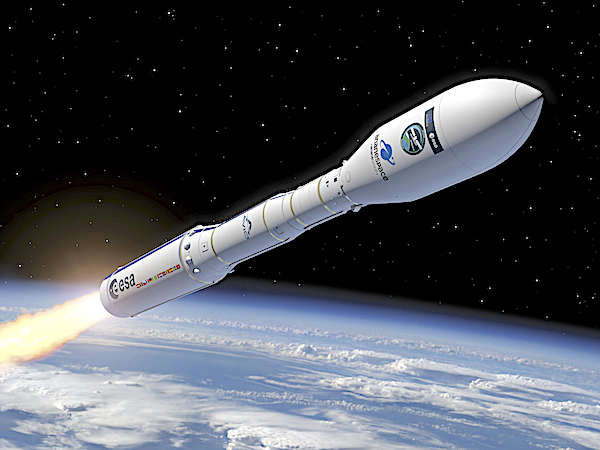
The third Copernicus Sentinel-1 satellite, Sentinel-1C, has launched aboard a Vega-C rocket, flight VV25, from Europe’s Spaceport in French Guiana. The rocket lifted off on 5 December 2024 at 22:20 CET (18:20 local time).
Sentinel-1C extends the legacy of its predecessors, delivering high-resolution radar imagery to monitor Earth’s changing environment, supporting a diverse range of applications and advance scientific research. Additionally, Sentinel-1C introduces new capabilities for detecting and monitoring maritime traffic.
The launch also marks Vega-C’s ‘return to flight’, a key step in restoring Europe’s independent access to space. Vega-C is the evolution of the Vega family of rockets and delivers increased performance, greater payload volume and improved competitiveness.

Ariane Launch Area 1 (ELV) has witnessed the launch of 51 rockets, including 51 orbital launch attempts, while Guiana Space Centre, French Guiana, has been the site for 323 rocket launches.
The third Copernicus Sentinel-1 satellite was launched on a Vega-C rocket from Europe’s Spaceport in French Guiana. Sentinel-1C extends the legacy of its predecessors, delivering high-resolution radar imagery to monitor Earth’s changing environment, supporting a diverse range of applications and advancing scientific research. Additionally, Sentinel-1C introduces new capabilities for detecting and monitoring maritime traffic.

Sentinel-1C was launched into orbit on 5 December, lifting off aboard Vega-C at 22:20 CET (18:20 local time). The launch proceeded smoothly, with the rocket reaching space in eight minutes and dropping off Sentinel-1C at approximately 00:04 CET.
The launcher’s mission, called VV25, is a return-to-flight for Vega-C – Europe’s lightweight, high-performance rocket – marking the restart of routine commercial operations for the new launcher. At 00:12 CET, ESA established communication with the satellite confirming that it was safely in orbit.
ESA’s Director General Josef Aschbacher said, “One moment combined two great European achievements today: the third launch of a Sentinel-1 satellite and the third launch of Vega-C, marking a triumphant return to form for both flagship European projects. It was exciting and touching to see the mix of the European launcher and Copernicus community and teams rooting each other on in true Team Europe form.
“With the insertion of Sentinel-1C into orbit, ESA continues a legacy of steadfast Sentinels protecting the Earth and exemplifies why Europe needs secured flights: because what we send to space provides benefits to Earth, and it all starts with a launch.”
ESA’s Director of Space Transportation Toni Tolker-Nielsen said, “Today’s launch marks a crucial step forward, reaffirming European independent access to space. With Vega-C back in flight and the inaugural launch of Ariane 6 in July, we are in a great place going forward and I salute all the hard-working teams all over Europe and its spaceport who have worked tirelessly to achieve this success.”
ESA’s Director of Earth Observation Programmes Simonetta Cheli added, “We are thrilled to celebrate the launch of Sentinel-1C, an example of the enduring partnership between ESA and the European Commission. The mission plays a crucial role in addressing global challenges like climate change and disaster response, while ensuring the continuity of vital radar data for monitoring Earth’s land, oceans and ice.
“With Sentinel-1C successfully in orbit and Vega-C back in flight, Europe continues to demonstrate its leadership in space, delivering tangible benefits for Earth through cutting-edge technology and collaboration.”
Mechanical issue delays ESA’s Vega-C’s launch of Sentinel-1C to Thursday

Update: launch postponed to Thursday 5 December 2024. Due to a mechanical issue preventing the withdrawal of the mobile gantry, the launch chronology has been stopped.
The earliest targeted launch date is planned for tomorrow Thursday 5 December 2024 at 22:20 CET (18:20 local time in Kourou). The launcher and its passenger the Copernicus Sentinel-1C satellite are in stable and safe conditions.
Tune in to ESA WebTV on 5 December from 22:00 CET to watch the satellite soar into space on a Vega-C rocket to be launched from Europe’s Spaceport in Kourou, French Guiana.
The launch will be the return to flight for Vega-C, Europe’s lightweight, high-performance rocket – further securing Europe’s autonomy in space after the successful launch of Ariane 6 last summer.
Once in orbit, Sentinel-1C will extend the Sentinel-1 mission’s legacy, delivering radar imagery to monitor Earth’s changing environment to support a diverse range of applications and scientific research.
The Copernicus Sentinel-1 mission provides all-weather, day-and-night radar imagery for the global monitoring of Earth’s land and oceans. The mission and data support critical areas such as environmental management, disaster response and climate change research.
Sentinel-1 data contributes to numerous Copernicus services and applications, including Arctic sea-ice monitoring, iceberg tracking, routine sea-ice mapping and glacier-velocity measurements. It also plays a vital role in marine surveillance, such as oil-spill detection, ship tracking for maritime security and monitoring illegal fishing activities.
Additionally, it is widely used for observing ground deformation caused by subsidence, earthquakes and volcanic activity, as well as for mapping forests, water and soil resources. The mission is crucial in supporting humanitarian aid and responding to crises worldwide.
The Sentinel-1 series began with Sentinel-1A, launched in April 2014, followed by Sentinel-1B in 2016. Each satellite is equipped with a C-band synthetic-aperture radar (SAR) instrument which operates in four modes and provides a spatial resolution down to 5 m and a swath of up to 410 km.
Although Sentinel-1B was retired in 2022 due to an electrical failure, Sentinel-1A remains fully operational, and has far exceeded its life expectancy of seven years.
The upcoming launch of Sentinel-1C will restore the mission to its full strength as a two-satellite constellation.
